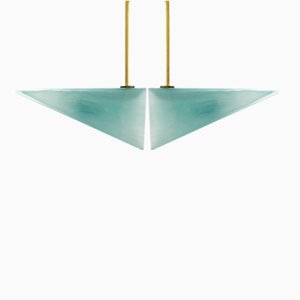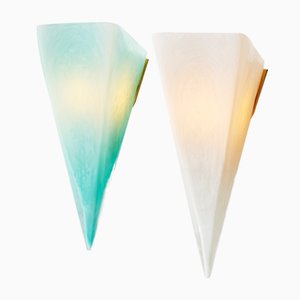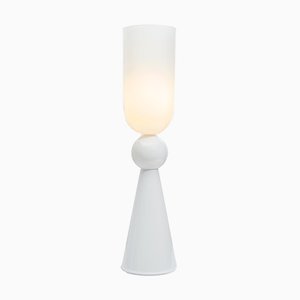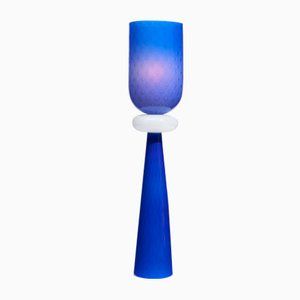A visit with upstart designer Anthony Bianco
The Contender
-
Anthony Bianco & Anna Carnick in conversation
<i>Photo © Giada Paoloni for L'AB/Pamono</i>
-
At Bianco's studio
<i>Photo © Giada Paoloni for L'AB/Pamono</i>
-
Bianco presents a hand-cut paper study in his Brooklyn studio
<i>Photo © Giada Paoloni for L'AB/Pamono</i>
-
Anthony Bianco & Anna Carnick in conversation
<i>Photo © Giada Paoloni for L'AB/Pamono</i>
-
Paper models at Bianco's studio
<i>Photo © Giada Paoloni for L'AB/Pamono</i>
-
An evolution of form: Models at Bianco's studio
<i>Photo © Giada Paoloni for L'AB/Pamono</i>
-
At Bianco's studio
<i>Photo © Giada Paoloni for L'AB/Pamono</i>
-
At Bianco's studio
<i>Photo © Giada Paoloni for L'AB/Pamono</i>
-
Paper study that evolved into Bianco's key lighting form
<i>Photo © Giada Paoloni for L'AB/Pamono</i>
-
Another one of Bianco's early paper studies
<i>Photo © Giada Paoloni for L'AB/Pamono</i>
-
AnNur, Yassin, and Cyrus at Bianco's studio
<i>Photo © Giada Paoloni for L'AB/Pamono</i>
-
Yassin at Bianco's studio
<i>Photo © Giada Paoloni for L'AB/Pamono</i>
-
Yassin at Bianco's studio
<i>Photo © Giada Paoloni for L'AB/Pamono</i>
-
Glass molding tool at Bianco's studio
<i>Photo © Giada Paoloni for L'AB/Pamono</i>
-
Glass molding tool at Bianco's studio
<i>Photo © Giada Paoloni for L'AB/Pamono</i>
-
At Bianco's studio
<i>Photo © Giada Paoloni for L'AB/Pamono</i>
-
Sketch plan for glassblowing
<i>Photo © Maria Bianco; courtesy of Bianco Light & Space</i>
-
Glassblowing at Brooklyn Glass, Gowanus, New York
<i>Photo © Maria Bianco; courtesy of Bianco Light & Space</i>
-
Glassblowing at Brooklyn Glass, Gowanus, New York
<i>Photo © Maria Bianco; courtesy of Bianco Light & Space</i>
-
Glassblowing at Brooklyn Glass, Gowanus, New York
<i>Photo © Maria Bianco; courtesy of Bianco Light & Space</i>
-
Glassblowing at Brooklyn Glass, Gowanus, New York
<i>Photo © Maria Bianco; courtesy of Bianco Light & Space</i>
-
Glassblowing at Brooklyn Glass, Gowanus, New York
<i>Photo © Maria Bianco; courtesy of Bianco Light & Space</i>
-
Glassblowing at Brooklyn Glass, Gowanus, New York
<i>Photo © Maria Bianco; courtesy of Bianco Light & Space</i>
-
Glassblowing at Brooklyn Glass, Gowanus, New York
<i>Photo © Maria Bianco; courtesy of Bianco Light & Space</i>
-
Glassblowing at Brooklyn Glass, Gowanus, New York
<i>Photo © Maria Bianco; courtesy of Bianco Light & Space</i>
-
Glassblowing at Brooklyn Glass, Gowanus, New York
<i>Photo © Maria Bianco; courtesy of Bianco Light & Space</i>
-
Glassblowing at Brooklyn Glass, Gowanus, New York
<i>Photo © Maria Bianco; courtesy of Bianco Light & Space</i>
-
Glassblowing at Brooklyn Glass, Gowanus, New York
<i>Photo © Maria Bianco; courtesy of Bianco Light & Space</i>
-
Glassblowing at Brooklyn Glass, Gowanus, New York
<i>Photo © Maria Bianco; courtesy of Bianco Light & Space</i>
-
Glassblowing at <a href="http://brooklynglass.com/" target="_blank">Brooklyn Glass</a>, Gowanus, New York
<i>Photo © Maria Bianco; courtesy of Bianco Light & Space</i>
-
Cyrus and Yassin at Bianco's studio
<i>Photo © Giada Paoloni for L'AB/Pamono</i>
On a fall afternoon, I stepped into the sunlit Bushwick apartment-slash-studio of sculptor and designer Anthony Bianco. The space is situated above a bike shop and a botanica (the latter sports a bright yellow awning with the tagline “Everything for your spiritual problems”), and the elevated J train periodically hums in the background.
Bianco is a relative newcomer to Brooklyn’s upstart creative scene. Though he’s lived in New York for more than five years, the Chicago-native spent his first few years in the city working as an assistant for glass artist Jeff Zimmerman, an experience he says introduced him to “the sort of design I’d been craving; to have artistic license while making functional works was so exciting.” He made the leap himself in 2013 and opened Bianco Light & Space.
Upon entering Bianco’s space, a trio of handmade lights stood before us, members of the first collection to come out of the new studio. Up close, the lights look almost alien. They reach eye-level, standing on geometric, brass bases that flow elegantly into elongated stalks, culminating in seductive, blown glass components—a series of pentagons, coupled, tripled and more, at once angled and organic—in translucent turquoise, emerald green, and milky white. The cumulative effect is futuristic, sophisticated, even otherworldly. Take a few steps back, though, and the pieces once more seem very much of this world—albeit of a different time; more 1920s than 2010s. From this perspective, Bianco’s lights definitely echo Art Deco, with clear tributes to the era’s tiered, glimmering ornateness and the skyscrapers that so inspired its aesthetic.
For Bianco, this dichotomy of responses is expected, intended even. Equal parts form and function, at their core, his lights are driven by an investigation into one dynamic, modular form. “I’m not really hung up on imbuing so much meaning into the work; for me, it’s really about finding [a shape] that’s already loaded, that already has intrinsic value to it. It leaves it open for the viewer to interpret. By developing and concentrating on this one, single module, I can articulate several different sculptural forms.”
He goes on, “It’s liberating to know you can drive your whole business off sheer love for one idea or form. That’s so freeing to me, and that's where I start my day, everyday.”
As we talk, he presents paper studies—simple gestures as well as intricate patterns, impressively drawn or sliced freehand—and it is easy to see the link between his original sketches and his final works. “A big part of my process is drawing—conceptual studies, investigations into forms, formal shapes—and building sculptures. I try to get my ideas fleshed out on paper, to really understand the concept on paper before it turns into function.”
Once he is satisfied with his drawn form, Bianco creates a paper model, toying with the shape and construction until he is confident enough to take it to the mold-making phase. This is generally a two-part process that involves a rougher, wooden mold (often using scrap wood) for troubleshooting mechanics and, finally, a more durable graphite mold that is taken to the glass works to create his final pieces.
Recognizing that many of his peers prefer to design on the computer, rather than paper, Bianco smiles and says, “I prefer [to go] basic, analog. That’s another part of what I love about my process, about being creative, and about having my own business; nobody’s telling me I’m doing it the wrong way. It’s like glass; you’ve got to learn the fundamentals, and then there’s really no rulebook.”
While Bianco would rather let viewers interpret his pieces on their own, he readily cites influences ranging from sculptors Alexander Calder and Barbara Hepworth to Italian Futurism, as well as Islamic infinity patterns and calligraphy. And he named the pieces in his first collection for both Sanskrit and Arabic words—the jade-topped , for example, was inspired by the Sanskrit word meaning “the secret in the light.” He remarks that his leanings towards these languages “speak volumes about my work that wouldn’t otherwise be apparent... I’m interested in a more ambiguous understanding or translation of god, and also a reverence for the stars and astrology that points towards a larger existence than a terrestrial one.”
Asked when these concepts first became important to him, Bianco points to a period six years ago, following a dramatic accident that almost killed him. Hit by a car while riding his bike, Bianco was immobilized and bedridden for nearly a year. “I felt like I got a new lease on life after [my accident]. I read up on religion and questioned my whole existence again; and a lot of what I knew in my life changed. I had to reevaluate what I did for a living, who I worked for, and what I made. It was very physically limiting; even the scale of the work I can make now has dramatically changed. But,” he recalls, “it allowed me to really get back to the process of drawing. I was totally immobilized, but my right arm was working, and I could sit up, so it was like, bring the f***ing paper on, I’m ready to start drawing! And so I did this body of work, these drawings,” he says, pointing to a framed set of colored drawings depicting the forms that ultimately became his first collection. “And that got me really going.”
At the time, Bianco was working in Chicago as a set designer for companies like Crate & Barrel and CB2, and he’d been happy. After his accident, however, “physically, I couldn’t do that job anymore.” He also realized that, ultimately, he wanted to work for himself, and in the disciplines for which he’d gone to school. (Bianco studied glass, sculpture, and wood furniture design at the California College of Arts, graduating with a Bachelor’s degree in 2004.) “I decided that I was going to find a way to make this work, so right after I got my cast off, the following day, I moved to New York. Right off the bat, I started working for Jeff Zimmerman... and I was able to connect the dots on how to use my skills as a glassworker and designer.”
He reflects, “It’s really rewarding to go from [a state where I thought] maybe I won’t ever blow glass again, to seeing where I am today—using my ingenuity, my toolset as a sculptor and an artist, my creative process.”
Asked for lessons learned or advice for others considering diving into the design world today? “It’s an exciting time to be working as an emerging designer in NYC,” Bianco says. “Follow your heart... and stick to your guns.”
Working images of Anthony Bianco were taken at Brooklyn Glass, New York.
-
Text by
-
Anna Carnick
Anna is Pamono’s Managing Editor. Her writing has appeared in several arts and culture publications, and she's edited over 20 books. Anna loves celebrating great artists, and seriously enjoys a good picnic.
-
-
Images by
-
Giada Paoloni
Giada is an Italian-born photographer and stylist with a passion for travel, food, and art.
-
More to Love
Equinox Pendant by Anthony Bianco for Bianco Light & Space

Pavillion Sconce from Bianco Light & Space, 2017

Totem 1 by Anthony Bianco for Bianco Light & Space, 2017

Totem 2 by Anthony Bianco for Bianco Light & Space, 2017

Totem 3 by Anthony Bianco for Bianco Light & Space, 2017

































 Inside Bianco's Bushwick studio
Photo © Giada Paoloni for L'AB/Pamono
Inside Bianco's Bushwick studio
Photo © Giada Paoloni for L'AB/Pamono

